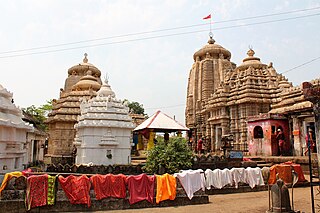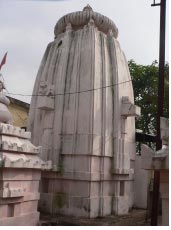
Kedareswar Temple, one of the eight Astasambhu Temples, is near the Mukteswar Temple, in Bhubaneswar, Odisha. The presiding deity is Shiva, referred to locally by the name ‘Kedareshwar’. It is in the precinct of Kedara-Gouri on the right side of the road leading to Puri from Bhubaneswar and at a distance of 40 metres south of Muktesvara. It is one of the ten monuments within the precinct. It is the main temple of the complex. The temple is facing south and the enshrined deity is a circular yonipitha made of sandstone. The linga at the centre is missing. The sanctum is 2.5 square meters which is 0.8 meters below the present ground. It stands near the yard of the Mukteswar Temple.
Jalesvara Siva Temple Precinct is a Hindu Temple dedicated to Shiva situated on the southern outskirt of the village Kalarahanga at a distance of 2.00 km from Patia and 6.00 km south of Chudangagada in the northern outskirt of Bhubaneswar, Odisha, India. The presiding deity is a Siva-lingam within a circular yonipitha inside the sanctum, which is 1.15 meters below the chandrasila. The sanctum measures 2.00 square meters.

The Kapilesvara temple is a Hindu temple dedicated to Shiva located in the south western outskirt of the village Kapilesvara, Old Town, Bhubaneswar, Odisha, India. It is located at the end of Kapilesvara road leading from Lingaraj temple to Kapilesvara Village. The presiding deity is a Siva-lingam at the center of a circular yonipitha inside the sanctum. It is a living temple, facing towards east and maintained by Kapilesvara Temple Trust Board. The temple is situated within the precinct along with 33 other monuments. The precinct is located on the northern embankment of Manikarnika tank over an area of 44.00 square metres.

Lokanatha Siva Temple also Amunha Deula is an 11th-century AD temple in Bhubaneswar in the state of Odisha, India. It represents a proto type of Lingaraja in a miniature form. Lokanatha Siva temple is located in front of the Lingaraja temple in the south eastern corner across the road and adjacent to Lingaraja Temple Police Station in Old Town, Bhubaneswar. Until 1972 the temple was buried from all sides up to the bandhana portion, giving an impression as if the temple had no entrance. Hence people called it Amuha deula. In 1972 Debala Mitra conducted an excavation in front of the northern wall and exposed the entrance. The sanctum was empty. However, on the basis of the local traditions and the sculptural embellishment on the outer wall it was ascribed to Lord Siva. It is now known both as Lokanatha Siva and Amuha deula. People ascribe the temple to the Kesharis (Somavamsis). Except the entrance all other sides it is buried up to the bandhana.

Arjunesvara Siva Temple is an abandoned 12th century temple in Bhubaneswar, in the Indian state of Orissa. The temple is situated on the southern embankment of the Bindusagar tank on the right side of the ratha road branching from the road connecting Lingaraja temple to Ramesvara temple.
The Bhringeswara Shiva temple is an 8th century Hindu temple situated on the foothills of Dhauli and the left bank of the Daya River, in the southeastern outskirts of Bhubaneswar(India) in the village Khatuapada. The temple is facing towards west and the presiding deity is a circular yoni pitha with a hole at the centre. The temple is made of light grey sandstone. The temple is renovated one from bottom to the top by employing the earlier materials. This temple is now under the protection of Odisha State Archaeology.

Champakeswara Shiva Temple is located Ambika Sahi in the Old Town area of Bhubaneswar in Odisha, India. It is 157 metres west of Parasuramesvara on the right side of the Kotitirthesvara lane leading to Bindu sagara. It is a laterite temple. Local people believe that the enshrined Siva lingam is patalaphuta and the precinct is the abode of nagas after whom the deity is named as Champakesvara. The local people also believe that the temple precinct which is a den for the snakes do not harm any body.
Patalesvara Siva Temple – I is a temple dedicated to Lord Shiva, located in Old Town, Bhubaneswar, Odisha,India. This temple dates back to 13th century, and belongs to the Ganga era. At present, this temple is situated inside the compound wall of a private residence.

Purvesvara Siva Temple is located in Kancha Sahi, in the Old Town of Bhubaneswar, Orissa, India. It was built in 13th century AD. It is a living temple and now under the care of Purvesvara Temple Development Association.

Isanesvara Siva Temple is a 13th-century ad temple in Bhubaneswar in the state of Orissa, India. The date of its construction is estimated from its architectural features and it is suggests the temple to ganga period. Isanesvara Siva temple is in the Goasagaresvartemple precinct, on the left side of Ratha road old Town, Bhubaneswar. It is one kilometre (0.62 mi) west of Lingaraja Temple and one km south of Ananta Vasudev, 300 m (980 ft) southwest of Ramesvara temple and 200 m (660 ft) northwest of Baitala Deula. The temple is facing towards east. The presiding deity is only a circular yon pitha. The lingam is missing.
Gangesvara Siva Temple is situated within a precinct on the left side of the Ganges–Yamuna road Old Town, Bhubaneswar, Orissa, India. It is located at a distance of 200 metres north-east of Lingaraj temple, 50 metres north of Lakhesvara temple across the road, 200 metres south of Subarnesvara and 100 metres east of Gourisankar temple. The temple is facing towards east. The presiding deity is a Siva lingam within a circular yonipitha. It is a living temple and maintained by the Ganga YamunaSangathana.
Ladu Baba Temple is a temple in Bhubaneswar, Odisha, India. It was built in the 13th century AD and was formerly known as Kainchhi Temple.
Lakhesvara Siva temple Location: Lat 20° 14’ 33"N, Long 85° 50’ 17" E, Elev 60 ft. Approach- Lakhesvara Siva temple is located in the right side of the Ganges–Yamuna road, behind the Lingaraja market complex, Old town, Bhubaneswar, Orissa, India. It is situated at a distance of 70 metres north east of Lingaraj temple and at a distance of 10 metres south of Gangesvara and Yamunesvara Siva temple across the road. The temple is facing towards the east. The enshrining deity is a Siva lingam within a circular yoni-pitha, which is 0.77 metres below the chandrasila.

Mangalesvara Siva Temple is a Hindu temple located in Bhubaneswar, Orissa, India. It is located at Lat- 20◦ 14’ 38" N., Long- 85◦ 50’ 38" E., and at an elevation of 45 ft.
Sarvatresvar Siva Temple is situated on the right side of Mahavir lane branching from Lewis road to Sisupalgarh, Bhubaneswar, Orissa, India. It enshrines a Siva-lingam within a circular yonipitha inside the sanctum. The temple precinct is located on the right bank of the stream Gangua.
Devasabha Temple is located in the Kharakhia Vaidyanath temple precinct, Old Town area of Bhubaneswar, Orissa, India. This is an abandoned temple and is facing towards the east. There is no deity inside the cella. As per the locals, the temple is the assembly of all gods and goddess for which it is known as Devasabha.
The Vishnu Temple, Bhubaneswar is a Hindu temple dedicated to Lord Vishnu situated on the eastern embankment of Bindu Sagar at Talabazar, on the right side of the Talabazar road leading from Lingaraj temple to Kedara-Gouri lane in Bhubaneswar, the capital of Odisha, India. The temple faces west and the Sanctum is used for storage purposes. The sculptural embellishment on the outer wall and the parsavadevatas in raha niche suggests that the temple was originally dedicated to Vishnu.
Subarnesvara Siva temple is situated on the left bank of Lingaraja west canal, Bhubaneswar, Orissa, India. The east facing ancient temple enshrines a Siva lingam within a circular yoni pitha in the sanctum measuring 2.35 square meters.

Suka Temple is an abandoned and unused temple in Bhubaneswar, the capital of Odisha, India. The temple is devoted to saptaratha and the presence of female counterparts of the dikpalas in the upara jangha. This was built in the matured phase of temple building tradition of Odisha.

Astasambhu Siva Temples is a collection of 8 Hindu temples dedicated to Lord Siva located in Bhubaneswar, the capital of Odisha, India.











